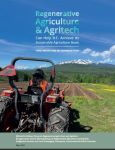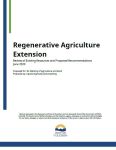Regenerative agriculture and agritech: Supporting sustainable agriculture
The Ministry of Agriculture and Food has developed a strategic framework emphasizing agritech’s role in fostering sustainable agriculture, addressing climate change and enabling food security.
From June 2022 to May 2023, the Ministry of Agriculture and Food convened an advisory process including the Minister’s Advisory Group on Regenerative Agriculture and Agritech, Indigenous food sovereignty champions, and a cohort of BC Agriculture Council farmers to provide strategic advice to the ministry on opportunities to promote innovation, technology adoption, and regenerative practices that will increase the productivity, profitability, and sustainability of British Columbia’s (B.C.’s) food system.
The extensive work done through this advisory process deepened the understanding of how regenerative agricultural practices and agritech (agricultural technology) support a sustainable approach to our economy, environment, and social needs. Sustainability means meeting the needs of today and preparing for tomorrow without compromising the ability of future generations to meet their needs.
The advisory process resulted in two major deliverables and a supplementary report:
Strategic framework outline
Vision
British Columbia’s food systems follow the principles of sustainable agriculture to continuously improve our lands, waters and ecosystems.
Mission
To accelerate sustainable agriculture through the implementation of regenerative agricultural practices, championing appropriate tools and agritech solutions, and fostering knowledge and technology transfer to help prepare for and mitigate climate change to ensure a food secure BC.
Values
- Appreciation and respect
- Collaboration
- Curiosity
- Data driven and science based
- Perseverance
- ReconciliAction
Goals and associated strategic priorities
Economic profitability:
- Place a well-resourced, practical, and innovative provincial extension network that is responsive to the realities and challenges faced by producers and agritech entrepreneurs
- Understand current baselines and benchmarks, develop regenerative agriculture guidelines, create incentives and reduce barriers for producers to further adopt and implement regenerative agricultural practices, as well as the technologies that support adoption
Social responsibility:
- Increase public awareness about the vulnerability of and the potential for B.C.’s local food systems, including how agriculture positively impacts the environment and supports climate action
- Ensure government programs and funding prioritize food system resiliency and food security
Environmental stewardship
- Ensure sustainable agriculture, regenerative agricultural practices and agritech programs are emphasized, developed, and integrated across government
- Increase knowledge on the state of soil health in the province, address the fundamental components that comprise soil health and create opportunities to leverage soil as tool to store carbon
Indigenous agriculture
- Address policy barriers, in partnership with other Ministries and agencies where needed, to expanding Indigenous agriculture and traditional food practices
- Ensure government programs and funding prioritize Indigenous Food Sovereignty and food security
- Advance Indigenous-led extension services as well as Indigenous- led training, skills, and capacity development initiatives in agriculture and food
Climate action is a focus of both the provincial and federal governments
Climate change impacts are projected to become considerably greater in scale and frequency as climate change escalates in B.C. This will affect food security, economic growth, and public health and wellbeing.
The atmospheric river event in 2021 was one of many extreme weather disasters in recent years. The Fraser Valley, specifically the Sumas Prairie, along with Merritt and Princeton, were extraordinarily affected with 1,100 farms and 15,000 hectares of farmland affected.
The broader provincial agricultural sector suffered additional direct and indirect impacts. B.C.’s wildfires, floods, and extreme heat domes are a strong reminder of why the B.C. government has prioritized collective actions to mitigate the effects of climate change and adapt to our changing environment.
The Government of Canada and the Government of B.C. continue to prioritize climate action, and are working together to recognize and support the agriculture sector:
- Federal, Provincial and Territorial 'Guelph Statement'; “Tackling climate change and environmental protection to support GHG emission reductions and the long-term vitality of the sector while positioning producers and processors to seize economic opportunities from evolving consumer demands”
- CleanBC Roadmap to 2030:
- “We will work with the agriculture sector to determine beneficial management practices to maximize carbon sequestration and its benefits to biodiversity, soil and water quality, and farm profitability…we will also encourage producers to implement regenerative agricultural practices and technologies that improve soil health and biodiversity, allowing farmland to store more carbon.”
B.C. has outlined its priorities for climate change action through initiatives such as the CleanBC Roadmap (PDF, 9.2 MB) to 2030:
- Increasing resilience to climate change risks (wildfire, flood, extreme heat, weather variability, extreme precipitation, pests/diseases) through on-farm planning, regional adaptation strategies, and cost-share supports
- Adapting to drought by ensuring adequate water quantity for agriculture through water use efficiency and water infrastructure
- Reducing GHG emissions, sequestering carbon, and building soil health through the increased adoption of agritech and regenerative agriculture practices
- Improving measurement of the climate change outcomes and progress tracking related to programming and initiatives
Farmers are embracing this spotlight and showcasing how they contribute to climate action
The agricultural sector is being recognized and supported in their commitment to environmental stewardship as contributors to climate action. This includes inviting farmers and producers to be part of the solution to the challenges that they experience. While B.C. primary agriculture is a small contributor to provincial and national GHG emissions, it is uniquely positioned to be an important part of the solution.
Highlighting B.C.’s regenerative producers
There are many regenerative farmers and ranchers in B.C. right now. See some of their stories here:
Producer profile: LH Willms Inc.
Hannah & Les Willms are third generation farmers who since 1993 have run a second generation farm LH Willms Inc, in Rose Prairie, B.C. (Treaty 8 territory on the traditional lands of the Dane-zaa people).
What drew you to regenerative farming practices?
In grain farming, soil health is a high priority. We know that healthy soils produce the best crops, both in the quality and quantity. The drive to grow better crops has taken us down this road of regenerative farming practices. 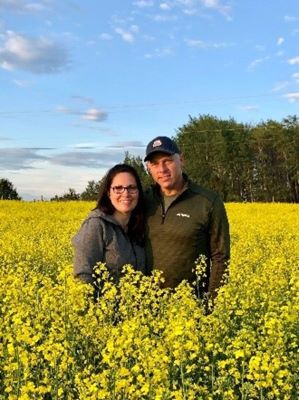
Which regenerative practices did you implement first on the farm?
Some of our first regenerative practices that we implemented on our farm were zero tillage, and leaving the straw and residue at harvest. These practices have built up organic matter.
Growing legumes has been another beneficial practice we have been rotating into our cropping system. We started with red clover in a few different scenarios and have moved towards growing alfalfa.
This past year we grew our first cover crops with a variety of blends and have found tillage radish, combined with crimson clover to be the most promising. We are currently in the research and development of this practice in the B.C. Peace region.
Which regenerative practices have you found to have the best return on investment (ROI)?
Zero tillage has been the regenerative practice that we have seen the greatest ROI. With savings in labour, fuel, equipment, and the ability to plant large acres in short amounts of time, as well as building organic matter in our soils, this practice made sense. It has been widely adopted by grain producers world-wide.
Another practice that has proven to be beneficial is growing legumes as green manure; often the subsequent crops will have a 10% yield increase.
Do you have advice for farmers interested in introducing regenerative practices on their farms?
Everything has a cost but taking part in regenerative practices that build soil will be beneficial in the long term.
Do you have any lessons learned you are interested in sharing?
One lesson learned has been switching from bias ply tires on our tractors, to tracked tractors. We still face compaction issues in the Peace region, but we can see a reduction of compaction in our fields by implementing this beneficial practice. Along with using tracked tractors in our fields, we have found that we need to stay off our land when it is too wet, whether it be seeding or harvest, otherwise compaction becomes a detriment to our soil that is not easy to correct. This is often hard especially in the north as we are always on a time crunch with our short growing season.
Producer profile: Clifton Ranch
Wade and Sandra Clifton and family run Clifton Ranch, established 1967 in Similkameen / South Okanagan on the Indigenous territory of the Okanagan-Sylix peoples, Keremeos, B.C.
Started by Wilson and June Clifton over 50 years ago and ran together with their sons, Brad and Wade for many years, Clifton Ranch is now run by Wade Clifton with wife Sandra and their family. They raise a herd of 500 cow-calf pairs and operate a feedlot for finishing cattle to direct market their homegrown beef to local consumers. 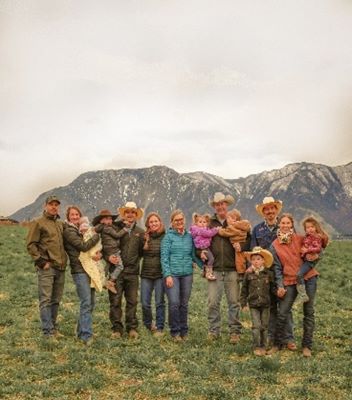
Since the beginning, Clifton Ranch has been working towards improving their environmental management practices while also maintaining an economically viable ranching operation conjunction with many environmental focused groups.
Clifton Ranch has a long-standing partnership with the Nature Trust of British Columbia to improvement water management, implement rotational grazing, and construct wildlife-friendly fencing. All of these practices are in place to ensure that their ranch exists in harmony with the natural ecosystems and the 50+ species at risk that call the land that they operate on home.
In 2019, the Clifton Ranch received two awards related to their environmental practices:
- The 2019 BC Cattlemen’s Association Ranch Sustainability Award
- The Environmental Stewardship Award (2019), presented by the Canadian Cattlemen’s Association
What drew you to regenerative farming practices?
Wade’s father, Wilson Clifton, always was interested in utilizing different practices to try to improve the land base and overall efficiency of the operation. Ranching in a regenerative way is the base behind what our family has always done and worked towards; however, we started focusing more closely on having specific regenerative management practice plans in place when we partnered with The Nature Trust of BC approximately 30 years ago.
Which regenerative practices did you implement first on the farm?
Rotational grazing between different pastures and ranges was always done in some manner, but as we were able to grow our land base, we were able to implement this in a more structured way. We now rotate pastures to allow more sensitive areas to rest every other year.
Which regenerative practices have you found have the best return on investment (ROI)?
Water is a key area of farming and ranching. Its importance sometimes gets overlooked. Between the various ranges and pastures there are over 100 water developments used to water the cattle and manage their grazing patterns.
These developments range from a 17,000-foot gravity fed system that we built down a mountain range. It has nine connecting troughs, simple spring and trough setups, and the use of solar power.
Having multiple water sources is key to being able to spread out the cattle over a broader area, leading to less negative effects and pressure on the grass and riparian areas. In the long run, the cattle eat better grass, gain more efficiently, and sensitive ecosystems around the riparian areas are more protected.
Do you have advice for farmers interested in introducing regenerative practices on their farms?
Most of what you are already doing operating is likely geared in a regenerative manner. It’s taking what you’re doing and making a committed action plan that you can execute to make improvements in areas that will benefit you more in the long term than the immediate term.
Keep in mind that there are changing factors that will influence how you operate, and you need to be willing to adapt to what makes the sense at the time and be willing to evolve to continue forward.
Do you have any lessons learned you are interested in sharing?
If you’re willing to look at regenerative opportunities in a positive light instead of another make work project, you will experience the long-term sustainability benefits in both an environmental and economical way. The end goal for everyone is the long-term viability of the land.
How is your land being affected by climate change and the increasing prevalence of wildfires?
In drier years, the grass becomes dormant faster on the lower grazing areas, luckily, we also have higher elevation range that we can move the cattle to for the second half of the year. Water is something we watch very closely. There are changes that we make to where the cattle graze, based on the accessibility of available water.
Have regenerative practices helped or hindered to reduce the effects of wildfires on your land?
The cattle graze down the grass so that there’s less potential fuel for the fires. There are actually certain areas that we focus the cattle on grazing more intensely to protect high value areas such as around the Dominion Radio Astrophysical Observatory that sits within our White Lake Basin range.
Producer profile: Crystal Lake Ranch
Werner and Jody Stump own Crystal Lake Ranch which has been in operation for over 64 years in Malakwa, B.C., the traditional territory of the Secwépemc Peoples. Their ranch is 870 acres, of which 340 of those are irrigated. In addition, they operate on a grazing license that encompasses 194,000 acres.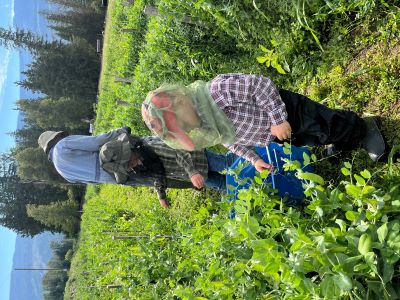
What drew you to regenerative farming practices?
Improved soil health and water quality are the primary environmental outcomes of regenerative farming practices.
The specific practices that contribute positively to soil health and water quality vary widely but these practices are included to some degree in probably every agriculture operation in BC. Looking after the land and water are key factors in the sustainability of every agriculture operation.
Which regenerative practices did you implement first on the farm?
Some of the first regenerative practices that we have implemented on our operation include silvopasture management systems, cover cropping, efficient water delivery systems, riparian habitat management, and nutrient re-cycling.
Which regenerative practice have you found have the best ROI?
So far, the highest economic return we have probably seen is gaining efficiency in our water delivery systems by moving toward pivot irrigation.
Do you have advice for farmers interested in introducing regenerative practices on their farms?
For farmers interested in introducing regenerative practices, I would say that you probably have already included at least one regenerative practice in your operation, because as farmers we are always thinking about the sustainability of our operations.
Sustainability is not defined as a destination, rather it is a continuous process of improvement of practices considering soil, water, air quality and biodiversity. Our understanding of the inter-relationships of these attributes continuously grows, and so our practices evolve.
Meeting the economic and food security needs of the present while striving to improve the foundational factors that influence agronomic productivity, environmental values and resilience is my definition of sustainability in agriculture.
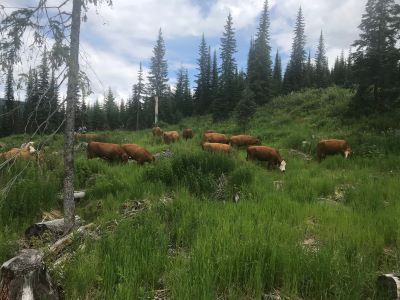
To farmers, soils are a primary resource, this is an opportunity to tell the story of environmental stewardship
Soil is one of B.C.’s most important resources. It supports the growth of fibre and food, acts as a filter for air and water, affects global climate through gas exchange and storage, contains a diverse array of organisms and supports natural ecosystems. Healthy soil plays a key role for B.C.’s economy and environment.
Description of regenerative practices
| Regenerative Practice | Examples | Description |
|---|---|---|
| Agroforestry |
|
Integration of suitable woody perennials into an agricultural landscape. Agroforestry practices refers to specific and recognized applications of agroforestry. |
| Animal integration into cropping system |
|
Integrating grazing livestock into green manure, cover crops or in silviculture setting. |
| Biochar | Charcoal produced from biomass used as a soil amendment | |
| Conservation tillage |
|
Limiting tillage practice during seed planting and crop cultivation can increase soil organic carbon and improve soil structure, leading to potential carbon sequestration and improved soil health, soil structure and biodiversity. |
| Cover cropping |
|
A cover crop is any plant species that is used in a farming system to improve or protect soil and provide a wide range of agronomic and environmental benefits. |
| Farmscaping |
|
Use of specific plants and landscape features to promote populations of beneficial organisms in agricultural systems. |
| Increasing plant diversity |
|
Rotating annual crops or companion planning to improve soils health, soil structure and biodiversity. |
| Integrated Pest Management |
|
Reduce pesticide application by using other pest management strategies to improve biodiversity on farms. |
| Managed grazing | The entire pasture is grazed uniformly to an appropriate degree within predetermined time frame, then the pasture is allowed to recover. | |
| Mulching |
|
Mulch used beneath perennial crops to enhance soil conditions and water use efficiency. |
| Organic matter recycling |
|
Recycling various organic materials such as compost and manures can increase soil organic matter to improve overall soil health and sequester some carbon. |
| Organic production |
|
Organic agriculture combines tradition, innovation, and science in a production system that seeks continuous improvement and sustains the health of soils, ecosystems, and people. Organic includes a set of codified practices that are third party verified and provides a market advantage. Organic Standards are reviewed and regularly updated and describe the approved practices and include a set of approved materials. |
| Set-asides |
|
Farmland that is taken out of production and set-aside for longer than a season to improve soil conditions or provide other ecosystem services. |
Sustainability in agriculture
The concept of sustainable agriculture is supported by three pillars: environmental stewardship, economic profitability, and social responsibility. Regenerative agriculture is a component of sustainable agriculture which relates to environmental stewardship and has been highlighted by the Province as a primary tactic in B.C.’s climate mitigation efforts.
Regenerative agriculture practices help restore the soil, water and biodiversity of the land, which allows farmland to become more resilient to climate change. Agritech supports these efforts with existing and innovative technology.
The context of regenerative agriculture and agritech in support of sustainable agriculture in B.C. was introduced at the inaugural regenBC conference in September 2021. The conference also showcased the benefit of collaborative efforts between technology, innovation, and farm practices to complement what farmers are already doing to make agriculture more environmentally sustainable.
Agritech
Agritech will play a key role in meeting the goals of the strategic framework. Agritech (agtech) is the development and application of technology to the agricultural and aquacultural sectors with the aim of optimizing production, profitability or environmental sustainability.
In addition to the over 150 agritech companies based in B.C., local producers and processors have been adopting innovative technologies from B.C. and around the world to improve their businesses and products.
Agritech solutions are advancing new knowledge and modernizing products, practices, and technologies to respond to new opportunities and emerging challenges. These measures will help us address climate change, food security, and increasing pressures on agricultural land.


